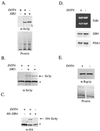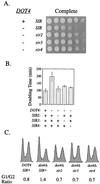DOT4 links silencing and cell growth in Saccharomyces cerevisiae
- PMID: 10490600
- PMCID: PMC84633
- DOI: 10.1128/MCB.19.10.6608
DOT4 links silencing and cell growth in Saccharomyces cerevisiae
Abstract
Transcriptional silencing in Saccharomyces cerevisiae occurs at specific loci and is mediated by a multiprotein complex that includes Rap1p and the Sir proteins. We studied the function of a recently identified gene, DOT4, that disrupts silencing when overexpressed. DOT4 encodes an ubiquitin processing protease (hydrolase) that is primarily located in the nucleus. By two-hybrid analysis, the amino-terminal third of Dot4p interacts with the silencing protein Sir4p. Cells lacking DOT4 exhibited reduced silencing and a corresponding decrease in the level of Sir4p. Together, these findings suggest that Dot4p regulates silencing by acting on Sir4p. In strains with several auxotrophic markers, loss of DOT4 ubiquitin hydrolase activity also results in a slow-growth defect. The defect can be partially suppressed by mutations in a subunit of the 26S proteasome, suggesting that Dot4p has the ability to prevent ubiquitin-mediated degradation. Furthermore, wild-type SIR2, SIR3, and SIR4 are required for full manifestation of the growth defect in a dot4 strain, indicating that the growth defect is caused in part by a silencing-related mechanism. We propose that Dot4p helps to restrict the location of silencing proteins to a limited set of genomic loci.
Figures








Similar articles
-
Distribution of a limited Sir2 protein pool regulates the strength of yeast rDNA silencing and is modulated by Sir4p.Genetics. 1998 Jul;149(3):1205-19. doi: 10.1093/genetics/149.3.1205. Genetics. 1998. PMID: 9649515 Free PMC article.
-
A deubiquitinating enzyme interacts with SIR4 and regulates silencing in S. cerevisiae.Cell. 1996 Aug 23;86(4):667-77. doi: 10.1016/s0092-8674(00)80139-7. Cell. 1996. PMID: 8752220
-
Analysis of Sir2p domains required for rDNA and telomeric silencing in Saccharomyces cerevisiae.Genetics. 2000 Mar;154(3):1069-83. doi: 10.1093/genetics/154.3.1069. Genetics. 2000. PMID: 10757754 Free PMC article.
-
The Sir proteins of Saccharomyces cerevisiae: mediators of transcriptional silencing and much more.Curr Opin Microbiol. 2000 Apr;3(2):132-7. doi: 10.1016/s1369-5274(00)00064-3. Curr Opin Microbiol. 2000. PMID: 10744999 Review.
-
Nuclear organization and silencing: trafficking of Sir proteins.Novartis Found Symp. 1998;214:114-26; discussion 126-32. doi: 10.1002/9780470515501.ch7. Novartis Found Symp. 1998. PMID: 9601014 Review.
Cited by
-
Deubiquitination step in the endocytic pathway of yeast plasma membrane proteins: crucial role of Doa4p ubiquitin isopeptidase.Mol Cell Biol. 2001 Jul;21(14):4482-94. doi: 10.1128/MCB.21.14.4482-4494.2001. Mol Cell Biol. 2001. PMID: 11416128 Free PMC article.
-
Interaction of Saccharomyces Cdc13p with Pol1p, Imp4p, Sir4p and Zds2p is involved in telomere replication, telomere maintenance and cell growth control.Nucleic Acids Res. 2004 Jan 23;32(2):511-21. doi: 10.1093/nar/gkh203. Print 2004. Nucleic Acids Res. 2004. PMID: 14742666 Free PMC article.
-
Ubp10/Dot4p regulates the persistence of ubiquitinated histone H2B: distinct roles in telomeric silencing and general chromatin.Mol Cell Biol. 2005 Jul;25(14):6123-39. doi: 10.1128/MCB.25.14.6123-6139.2005. Mol Cell Biol. 2005. PMID: 15988024 Free PMC article.
-
The deubiquitylation activity of Ubp8 is dependent upon Sgf11 and its association with the SAGA complex.Mol Cell Biol. 2005 Feb;25(3):1173-82. doi: 10.1128/MCB.25.3.1173-1182.2005. Mol Cell Biol. 2005. PMID: 15657442 Free PMC article.
-
The ubiquitin-specific protease family from Arabidopsis. AtUBP1 and 2 are required for the resistance to the amino acid analog canavanine.Plant Physiol. 2000 Dec;124(4):1828-43. doi: 10.1104/pp.124.4.1828. Plant Physiol. 2000. PMID: 11115897 Free PMC article.
References
-
- Adams A, Gottschling D E, Kaiser C A, Stearns T. Methods in yeast genetics. Cold Spring Harbor, N.Y: Cold Spring Harbor Laboratory Press; 1997.
-
- Aparicio O M, Billington B L, Gottschling D E. Modifiers of position effect are shared between telomeric and silent mating-type loci in S. cerevisiae. Cell. 1991;66:1279–1287. - PubMed
-
- Aparicio O M, Gottschling D E. Overcoming telomeric silencing: a trans-activator competes to establish gene expression in a cell cycle-dependent way. Genes Dev. 1994;8:1133–1146. - PubMed
-
- Ausubel F M, Brent R, Kingston R E, Moore D O, Seidman J G, Smith J A, Struhl K, editors. Current protocols in molecular biology. New York, N.Y: John Wiley & Sons; 1998.
Publication types
MeSH terms
Substances
Grants and funding
LinkOut - more resources
Full Text Sources
Molecular Biology Databases
